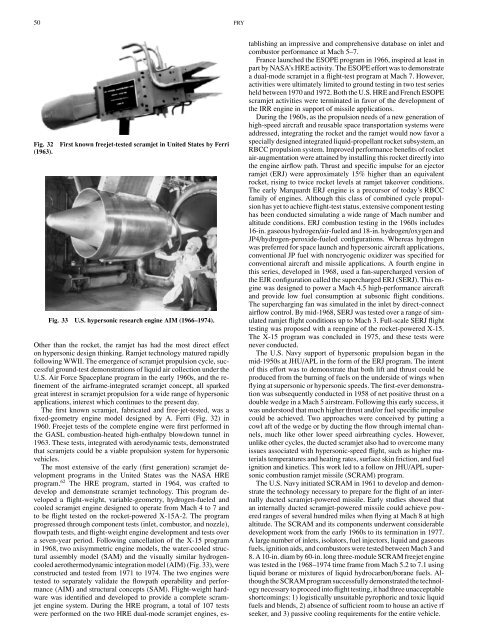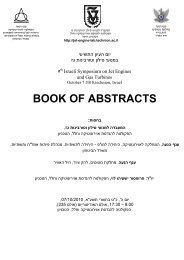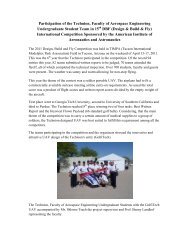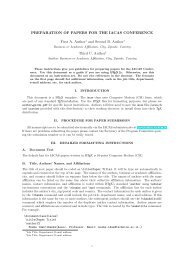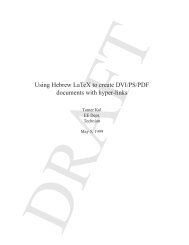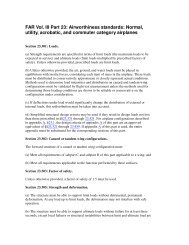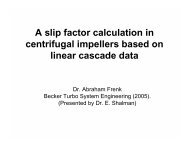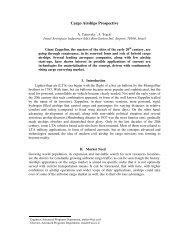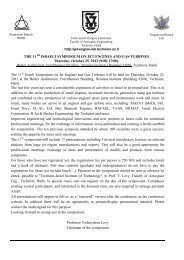A Century of Ramjet Propulsion Technology Evolution - Faculty of ...
A Century of Ramjet Propulsion Technology Evolution - Faculty of ...
A Century of Ramjet Propulsion Technology Evolution - Faculty of ...
Create successful ePaper yourself
Turn your PDF publications into a flip-book with our unique Google optimized e-Paper software.
50 FRY<br />
Fig. 32 First known freejet-tested scramjet in United States by Ferri<br />
(1963).<br />
Fig. 33 U.S. hypersonic research engine AIM (1966–1974).<br />
Other than the rocket, the ramjet has had the most direct effect<br />
on hypersonic design thinking. <strong>Ramjet</strong> technology matured rapidly<br />
following WWII. The emergence <strong>of</strong> scramjet propulsion cycle, successful<br />
ground-test demonstrations <strong>of</strong> liquid air collection under the<br />
U.S. Air Force Spaceplane program in the early 1960s, and the refinement<br />
<strong>of</strong> the airframe-integrated scramjet concept, all sparked<br />
great interest in scramjet propulsion for a wide range <strong>of</strong> hypersonic<br />
applications, interest which continues to the present day.<br />
The first known scramjet, fabricated and free-jet-tested, was a<br />
fixed-geometry engine model designed by A. Ferri (Fig. 32) in<br />
1960. Freejet tests <strong>of</strong> the complete engine were first performed in<br />
the GASL combustion-heated high-enthalpy blowdown tunnel in<br />
1963. These tests, integrated with aerodynamic tests, demonstrated<br />
that scramjets could be a viable propulsion system for hypersonic<br />
vehicles.<br />
The most extensive <strong>of</strong> the early (first generation) scramjet development<br />
programs in the United States was the NASA HRE<br />
program. 62 The HRE program, started in 1964, was crafted to<br />
develop and demonstrate scramjet technology. This program developed<br />
a flight-weight, variable-geometry, hydrogen-fueled and<br />
cooled scramjet engine designed to operate from Mach 4 to 7 and<br />
to be flight tested on the rocket-powered X-15A-2. The program<br />
progressed through component tests (inlet, combustor, and nozzle),<br />
flowpath tests, and flight-weight engine development and tests over<br />
aseven-year period. Following cancellation <strong>of</strong> the X-15 program<br />
in 1968, two axisymmetric engine models, the water-cooled structural<br />
assembly model (SAM) and the visually similar hydrogencooled<br />
aerothermodynamic integration model (AIM) (Fig. 33), were<br />
constructed and tested from 1971 to 1974. The two engines were<br />
tested to separately validate the flowpath operability and performance<br />
(AIM) and structural concepts (SAM). Flight-weight hardware<br />
was identified and developed to provide a complete scramjet<br />
engine system. During the HRE program, a total <strong>of</strong> 107 tests<br />
were performed on the two HRE dual-mode scramjet engines, es-<br />
tablishing an impressive and comprehensive database on inlet and<br />
combustor performance at Mach 5–7.<br />
France launched the ESOPE program in 1966, inspired at least in<br />
part by NASA’s HRE activity. The ESOPE effort was to demonstrate<br />
a dual-mode scramjet in a flight-test program at Mach 7. However,<br />
activities were ultimately limited to ground testing in two test series<br />
held between 1970 and 1972. Both the U.S. HRE and French ESOPE<br />
scramjet activities were terminated in favor <strong>of</strong> the development <strong>of</strong><br />
the IRR engine in support <strong>of</strong> missile applications.<br />
During the 1960s, as the propulsion needs <strong>of</strong> a new generation <strong>of</strong><br />
high-speed aircraft and reusable space transportation systems were<br />
addressed, integrating the rocket and the ramjet would now favor a<br />
specially designed integrated liquid-propellant rocket subsystem, an<br />
RBCC propulsion system. Improved performance benefits <strong>of</strong> rocket<br />
air-augmentation were attained by installing this rocket directly into<br />
the engine airflow path. Thrust and specific impulse for an ejector<br />
ramjet (ERJ) were approximately 15% higher than an equivalent<br />
rocket, rising to twice rocket levels at ramjet takeover conditions.<br />
The early Marquardt ERJ engine is a precursor <strong>of</strong> today’s RBCC<br />
family <strong>of</strong> engines. Although this class <strong>of</strong> combined cycle propulsion<br />
has yet to achieve flight-test status, extensive component testing<br />
has been conducted simulating a wide range <strong>of</strong> Mach number and<br />
altitude conditions. ERJ combustion testing in the 1960s includes<br />
16-in. gaseous hydrogen/air-fueled and 18-in. hydrogen/oxygen and<br />
JP4/hydrogen-peroxide-fueled configurations. Whereas hydrogen<br />
was preferred for space launch and hypersonic aircraft applications,<br />
conventional JP fuel with noncryogenic oxidizer was specified for<br />
conventional aircraft and missile applications. A fourth engine in<br />
this series, developed in 1968, used a fan-supercharged version <strong>of</strong><br />
the EJR configuration called the supercharged ERJ (SERJ). This engine<br />
was designed to power a Mach 4.5 high-performance aircraft<br />
and provide low fuel consumption at subsonic flight conditions.<br />
The supercharging fan was simulated in the inlet by direct-connect<br />
airflow control. By mid-1968, SERJ was tested over a range <strong>of</strong> simulated<br />
ramjet flight conditions up to Mach 3. Full-scale SERJ flight<br />
testing was proposed with a reengine <strong>of</strong> the rocket-powered X-15.<br />
The X-15 program was concluded in 1975, and these tests were<br />
never conducted.<br />
The U.S. Navy support <strong>of</strong> hypersonic propulsion began in the<br />
mid-1950s at JHU/APL in the form <strong>of</strong> the ERJ program. The intent<br />
<strong>of</strong> this effort was to demonstrate that both lift and thrust could be<br />
produced from the burning <strong>of</strong> fuels on the underside <strong>of</strong> wings when<br />
flying at supersonic or hypersonic speeds. The first-ever demonstration<br />
was subsequently conducted in 1958 <strong>of</strong> net positive thrust on a<br />
double wedge in a Mach 5 airstream. Following this early success, it<br />
was understood that much higher thrust and/or fuel specific impulse<br />
could be achieved. Two approaches were conceived by putting a<br />
cowl aft <strong>of</strong> the wedge or by ducting the flow through internal channels,<br />
much like other lower speed airbreathing cycles. However,<br />
unlike other cycles, the ducted scramjet also had to overcome many<br />
issues associated with hypersonic-speed flight, such as higher materials<br />
temperatures and heating rates, surface skin friction, and fuel<br />
ignition and kinetics. This work led to a follow on JHU/APL supersonic<br />
combustion ramjet missile (SCRAM) program.<br />
The U.S. Navy initiated SCRAM in 1961 to develop and demonstrate<br />
the technology necessary to prepare for the flight <strong>of</strong> an internally<br />
ducted scramjet-powered missile. Early studies showed that<br />
an internally ducted scramjet-powered missile could achieve powered<br />
ranges <strong>of</strong> several hundred miles when flying at Mach 8 at high<br />
altitude. The SCRAM and its components underwent considerable<br />
development work from the early 1960s to its termination in 1977.<br />
A large number <strong>of</strong> inlets, isolators, fuel injectors, liquid and gaseous<br />
fuels, ignition aids, and combustors were tested between Mach 3 and<br />
8. A 10-in. diam by 60-in. long three-module SCRAM freejet engine<br />
was tested in the 1968–1974 time frame from Mach 5.2 to 7.1 using<br />
liquid borane or mixtures <strong>of</strong> liquid hydrocarbon/borane fuels. Although<br />
the SCRAM program successfully demonstrated the technology<br />
necessary to proceed into flight testing, it had three unacceptable<br />
shortcomings: 1) logistically unsuitable pyrophoric and toxic liquid<br />
fuels and blends, 2) absence <strong>of</strong> sufficient room to house an active rf<br />
seeker, and 3) passive cooling requirements for the entire vehicle.


